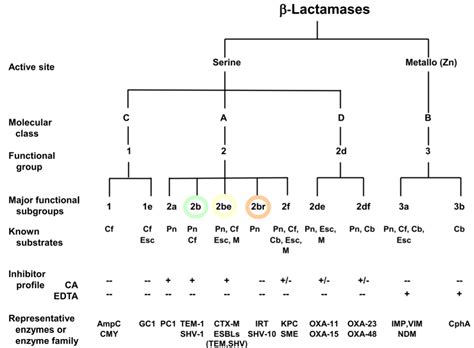beta lactamases|β : Bacolod Beta-lactamases are a diverse class of enzymes produced by bacteria that break open the beta-lactam ring, inactivating the beta-lactam antibiotic. Some beta-lactamases are encoded on mobile genetic elements (eg, plasmids); others are encoded on chromosomes. 1 Megavatios = 1000 Kilovatios: 10 Megavatios = 10000 Kilovatios: 2500 Megavatios = 2500000 Kilovatios: 2 Megavatios = 2000 Kilovatios: 20 Megavatios = 20000 Kilovatios: 5000 Megavatios = 5000000 Kilovatios: 3 Megavatios = 3000 Kilovatios: 30 Megavatios = 30000 Kilovatios: 10000 Megavatios = 10000000 Kilovatios: 4 Megavatios = 4000 .

beta lactamases,
Beta-lactamases (β-lactamases) are enzymes (EC 3.5.2.6) produced by bacteria that provide multi-resistance to beta-lactam antibiotics such as penicillins, cephalosporins, cephamycins, monobactams and carbapenems , although carbapenems are relatively resistant to .

β-Lactamases are bacterial hydrolases that bind and acylate β-lactam antibiotics, much like PBPs, and then use strategically positioned water molecules to hydrolyze and inactivate the antibiotic before it can reach its target (Drawz and Bonomo 2010). In this manner, the β-lactamase is regenerated and can inactivate additional antibiotic .beta lactamasesβ-Lactamases are bacterial hydrolases that bind and acylate β-lactam antibiotics, much like PBPs, and then use strategically positioned water molecules to hydrolyze and inactivate the antibiotic before it can reach its target (Drawz and Bonomo 2010). In this manner, the β-lactamase is regenerated and can inactivate additional antibiotic .beta lactamases ββ-Lactamases are bacterial hydrolases that bind and acylate β-lactam antibiotics, much like PBPs, and then use strategically positioned water molecules to hydrolyze and inactivate the antibiotic before it can reach its target (Drawz and Bonomo 2010). In this manner, the β-lactamase is regenerated and can inactivate additional antibiotic .
Beta-lactamases are a diverse class of enzymes produced by bacteria that break open the beta-lactam ring, inactivating the beta-lactam antibiotic. Some beta-lactamases are encoded on mobile genetic elements (eg, plasmids); others are encoded on chromosomes.Lang P.A., Parkova A., Leissing T.M., Calvopina K., Cain R., Krajnc A., Panduwawala T.D., Philippe J., Fishwick C.W.G., Trapencieris P., et al. Bicyclic boronates as potent inhibitors of AmpC, the class C beta-lactamase from Escherichia coli. Biomolecules. 2020;10:899. doi: 10.3390/biom10060899. [PMC free article] [Google Scholar] 16.ESBL stands for extended-spectrum beta-lactamases, i.e., a group of enzymes produced by Gram-negative and Gram-positive bacteria that can hydrolyze all β- lactam agents except carbapenems and cephamycins. On the basis of the protein sequence, beta-lactamases have been divided into four classes from A to D. Classes A, C and D hydrolyse their substrates by forming an acyl enzyme through an active site serine, whereas class B beta-lactamases which are metallo-enzymes utilize at active site zinc ion to facilitate hydrolysis of their substrate.Beta-lactamases are genetically and structurally closely related to penicillin-binding proteins. Their production by bacteria is a major mechanism of resistance to the action of beta-lactam antibiotics. Drugs have therefore been developed that inhibit beta-lactamase, as a .
Beta-lactam antibiotics are those that contain 4-member, nitrogen-containing, beta-lactam ring at the core of their structure. This ring mimics the shape of the terminal D-Ala-D-Ala peptide sequence that serves as the substrate for cell wall transpeptidases.
beta lactamases|β
PH0 · β
PH1 · Overview of Beta
PH2 · ESBL and Classification of β
PH3 · Classification of β
PH4 · Beta